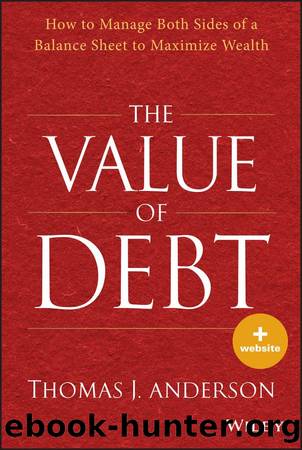The Value of Debt: How to Manage Both Sides of a Balance Sheet to Maximize Wealth by Thomas J. Anderson

Author:Thomas J. Anderson [Anderson, Thomas J.]
Language: eng
Format: azw3
Publisher: Wiley
Published: 2013-08-27T16:00:00+00:00
Purchasing a Second Home: Pluses and Minuses
In Chapter 3, when discussing how to determine your optimal debt ratio, we discussed at some length the question of whether your primary residence should be included in your optimal debt ratio. We concluded that for some people, thereâs no question that their primary residence should be free and clearâwith no debt on itâas this is emotionally important to them. However, as a way to add desirable debt into your overall financial equation, the purchase of a second home may prove very promising.
Before considering how you might go about purchasing a second home, letâs start by reviewing some of the disadvantages of owning a second home and whether you might want to just rent a vacation home instead. That is, before even beginning to look for a second home for vacation or investment or adding in good debt to the mix, you want to be well aware of the expenses and other factors typically associated with owning a second home. Letâs go through these one by one.
Depreciation
To begin with, homes have multiple expenses associated with them that are often not fully factored into the cost of ownership and the likely rate of return on the property, starting with depreciation. If you were to build a new house and leave it in the middle of a cornfield for 50 years, and then you came back and visited it, thereâd be no part of the property that you would still be able to use. Youâd essentially have to replace everythingâthe house would need a new roof, new windows, new carpeting, new appliances, new bathrooms, and so on. With a 50-year time horizon, this implies a 2 percent annual depreciation on the house just to maintain it and keep it exactly the same; if you assume a 30-year period, then that means approximately a 3 percent yearly depreciation cost.
It is important to apply this to the value of the building and not the land. So letâs say that you have a lot worth $100,000 and you have a $1 million property on that lot for a total value of $1.1 million. In this example it is reasonable to assume that you will have somewhere between $20,000 and $30,000 a year of maintenance expenses just to keep the building in the same condition. Alternatively, if you have a $5 million property with $2 million of structure and $3 million of lot, then your depreciation may run closer to $60,000 per year (3% Ã $2 million). Separating the land value from the building value is particularly important in areas with high land values (coasts and cities) and less important where the land value is less than 30 percent of the value of the property.
Clearly these expenses wonât be evenly distributed. With respect to new construction, the first two years tend to be expenses that are more related to finishing work versus maintenance. Years 3â10 tend to not have as much maintenance, but homeowners tend to underestimate the deferred maintenance that is building up.
Download
This site does not store any files on its server. We only index and link to content provided by other sites. Please contact the content providers to delete copyright contents if any and email us, we'll remove relevant links or contents immediately.
Time Management Made Easy: How to Cultivate New Habits, Improve Productivity and Get Things Done by Joshua Strachan(2377)
The 7 Habits of Highly Effective People by Stephen R. Covey & Sean Covey(2178)
The Concise Laws of Human Nature by Robert Greene(1762)
Doesn't Hurt to Ask by Trey Gowdy(1582)
Primal Leadership by Daniel Goleman(1181)
Hook Point: How to Stand Out in a 3-Second World by Brendan Kane(1125)
HBR's 10 Must Reads 2021 by unknow(1059)
Don't Sweat the Small Stuff...and It's All Small Stuff by Richard Carlson(1051)
Amazon Unbound by Brad Stone(996)
100 Things Successful People Do by Nigel Cumberland(980)
HBR's 10 Must Reads 2021 by Harvard Business Review(970)
The Job Closer by Steve Dalton(956)
Master of One by Jordan Raynor(952)
Lives of the Stoics by Ryan Holiday & Stephen Hanselman(916)
Declutter Your Mind: A step by step guide to learn to control your thoughts, stop worrying, relieve anxiety and eliminate panic attacks and negative thinking by Mia Chandler(906)
The Power of 100! by Shaun King(890)
Conflicted by Ian Leslie(817)
Coders at Work: Reflections on the craft of programming by Peter Seibel(805)
The Book of Hope by Jane Goodall(779)
